


 While apples can be found year-round, their prime harvesting season (in the northern hemisphere) is late summer through fall. They're perfect for spiced teas, fall smoothies or making sweet apple pies. The countless ways you can use apples this fall season will have you buying them every chance you get.
Curious to know which apple you should use to bake the perfect apple pie? Check out our Complete Guide on the Best Apples for Apple Pie.
While apples can be found year-round, their prime harvesting season (in the northern hemisphere) is late summer through fall. They're perfect for spiced teas, fall smoothies or making sweet apple pies. The countless ways you can use apples this fall season will have you buying them every chance you get.
Curious to know which apple you should use to bake the perfect apple pie? Check out our Complete Guide on the Best Apples for Apple Pie.
 Did you know that Brussels sprouts grow on a stalk? Most commonly harvested in the fall, Brussels sprouts can often be purchased with the stem still intact during this season. Purchasing Brussels sprouts this way will help keep this powerhouse of a veggie fresher for longer. Plus, you can be confident that they are indeed farm to table!
Add brussel sprouts to your list of pizza toppings and make this mouthwatering Winter Harvest Pizza. Perfect for warming up the house and the dinner table!
Did you know that Brussels sprouts grow on a stalk? Most commonly harvested in the fall, Brussels sprouts can often be purchased with the stem still intact during this season. Purchasing Brussels sprouts this way will help keep this powerhouse of a veggie fresher for longer. Plus, you can be confident that they are indeed farm to table!
Add brussel sprouts to your list of pizza toppings and make this mouthwatering Winter Harvest Pizza. Perfect for warming up the house and the dinner table!
 Kale tastes just as great as it is for you - which is incredible! Cooler temperatures keep kale sweet, which means it tastes best when cut in the fall and winter months. Dont know how to cook kale? Dont worry, its easy! Use kale in your favorite seasonal salad recipe, or season and bake it to create delicious low-carb chips.
Surprise your family with a healthy version of their favorite comfort food and make these Black Bean and Creamy Kale Enchiladas.
Kale tastes just as great as it is for you - which is incredible! Cooler temperatures keep kale sweet, which means it tastes best when cut in the fall and winter months. Dont know how to cook kale? Dont worry, its easy! Use kale in your favorite seasonal salad recipe, or season and bake it to create delicious low-carb chips.
Surprise your family with a healthy version of their favorite comfort food and make these Black Bean and Creamy Kale Enchiladas.
 Quinoa is derived from a broadleaf plant whose seeds are used much like grains. Being a cool season plant, quinoa is most successively harvested in fall. An excellent plant-based protein source, quinoa makes for a great grain bowl base and can even be used to make veggie burgers. Quinoa can also be added to soups and salads and mixed with other grains to boost essential vitamins, nutrients and protein.
Quinoa is derived from a broadleaf plant whose seeds are used much like grains. Being a cool season plant, quinoa is most successively harvested in fall. An excellent plant-based protein source, quinoa makes for a great grain bowl base and can even be used to make veggie burgers. Quinoa can also be added to soups and salads and mixed with other grains to boost essential vitamins, nutrients and protein.
 Fall and pumpkins go together. With pumpkin spiced lattes and pumpkin pies being sold just about everywhere, it's no secret that pumpkin is a fall/winter squash. The pumpkins' flesh can be turned into delicious soups, Gluten Free Pumpkin Pancakes, pies and even cubed and added to a savory salad recipe. Pumpkin seeds also provide a great source of antioxidants. To enjoy, season them with a bit of olive oil and salt and bake in the oven until fully cooked. Yum!
Fall and pumpkins go together. With pumpkin spiced lattes and pumpkin pies being sold just about everywhere, it's no secret that pumpkin is a fall/winter squash. The pumpkins' flesh can be turned into delicious soups, Gluten Free Pumpkin Pancakes, pies and even cubed and added to a savory salad recipe. Pumpkin seeds also provide a great source of antioxidants. To enjoy, season them with a bit of olive oil and salt and bake in the oven until fully cooked. Yum!